剑桥国际英语教程(入门级)5单元上
- 格式:ppt
- 大小:282.50 KB
- 文档页数:20
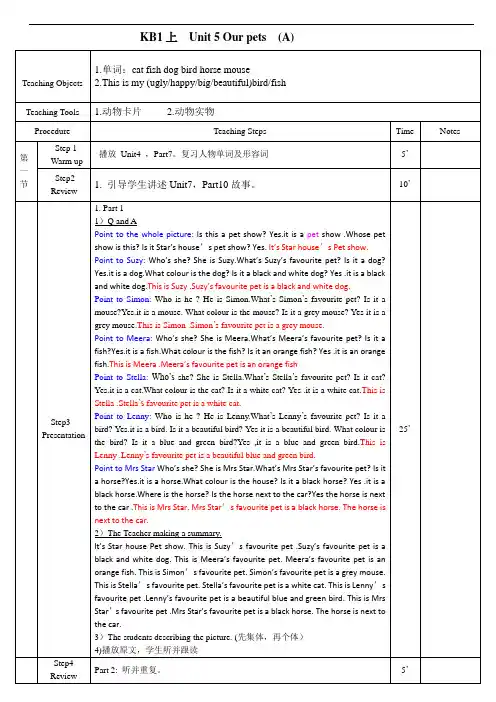

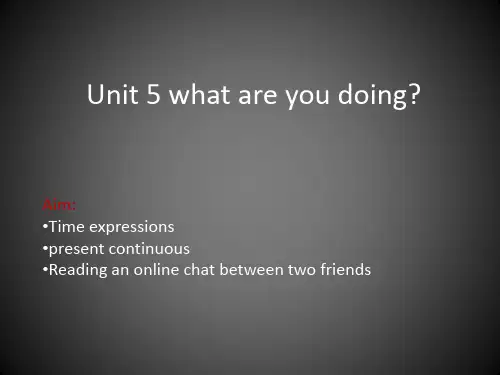
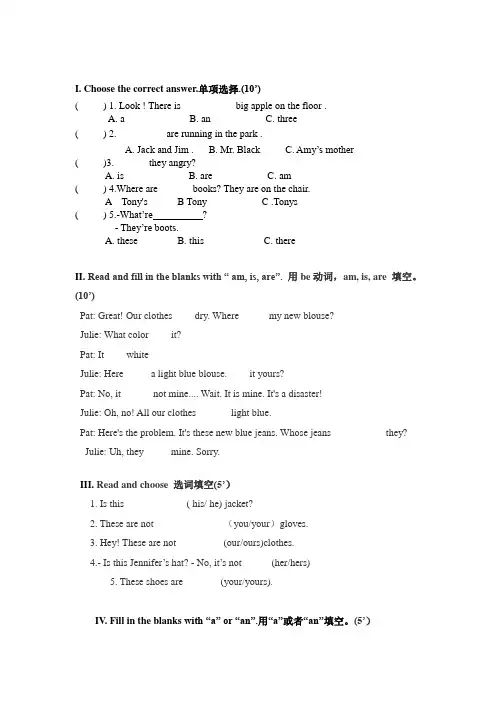
I. Choose the correct answer.单项选择.(10’)( ) 1. Look ! There is __________ big apple on the floor .A. aB. anC. three( ) 2. _________ are running in the park .A. Jack and Jim .B. Mr. BlackC. Amy’s mother( )3. ______ they angry?A. isB. areC. am( ) 4.Where are ______ books? They are on the chair.A Tony'sB TonyC .Tonys( ) 5.-What’re?- They’re boots.A. theseB. thisC. thereII. Read and fill in the blanks with “ am, is, are”. 用be动词,am, is, are 填空。
(10’)Pat: Great! Our clothes ____dry. Where _____ my new blouse?Julie: What color____ it?Pat: It____ whiteJulie: Here _____a light blue blouse. ____it yours?Pat: No, it ______not mine.... Wait. It is mine. It's a disaster!Julie: Oh, no! All our clothes ______ light blue.Pat: Here's the problem. It's these new blue jeans. Whose jeans _________they? Julie: Uh, they_____ mine. Sorry.III. Read and choose 选词填空(5’)1. Is this ____________( his/ he) jacket?2. These are not ____________(you/your)gloves.3. Hey! These are not _________(our/ours)clothes.4.- Is this Jennifer’s hat? - No, it’s not______(her/hers)5. These shoes are _______(your/yours).IV.Fill in the blanks with “a” or “an”.用“a”或者“an”填空。
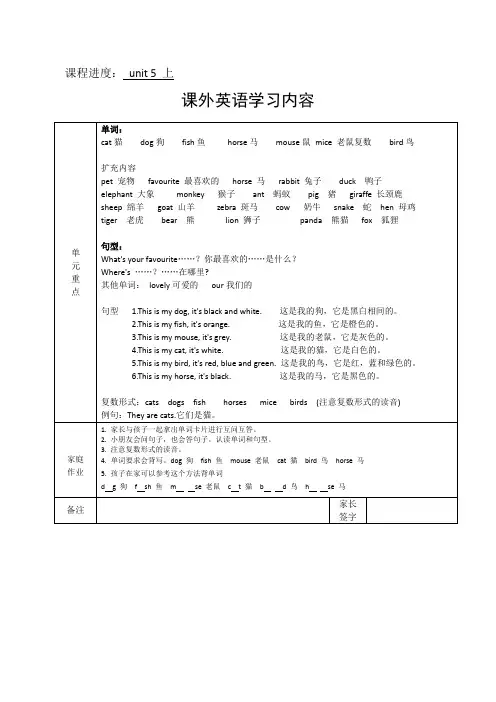
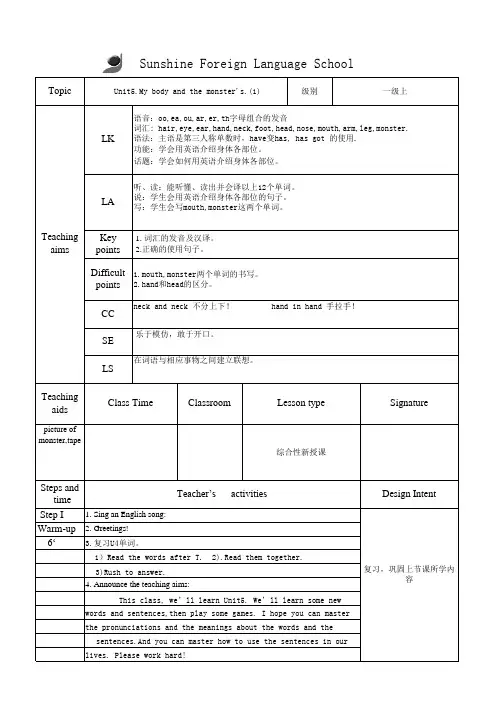
Step IWarm-up 6‘Sunshine Foreign Language School综合性新授课乐于模仿,敢于开口。
复习,巩固上节课所学内容CC Key points1. 词汇的发音及汉译。
2.正确的使用句子。
Difficult points 1.mouth,monster两个单词的书写。
2.hand和head的区分。
words and sentences,then play some games. I hope you can master the pronunciations and the meanings about the words and the 4. Announce the teaching aims:sentences.And you can master how to use the sentences in our 3.复习U4单词。
Design Intent1. Sing an English song:2. Greetings!级别lives. Please work hard!picture of monster,tapeSignatureSteps andtimeTopicUnit5.My body and the monster's.(1)neck and neck 不分上下! hand in hand 手拉手!在词语与相应事物之间建立联想。
Lesson type Teaching aimsSE 一级上LSLK语音:oo,ea,ou,ar,er,th字母组合的发音词汇: hair,eye,ear,hand,neck,foot,head,nose,mouth,arm,leg,monster.语法:主语是第三人称单数时,have变has, has got 的使用.功能:学会用英语介绍身体各部位。
话题:学会如何用英语介绍身体各部位。
LA听、读:能听懂、读出并会译以上12个单词。
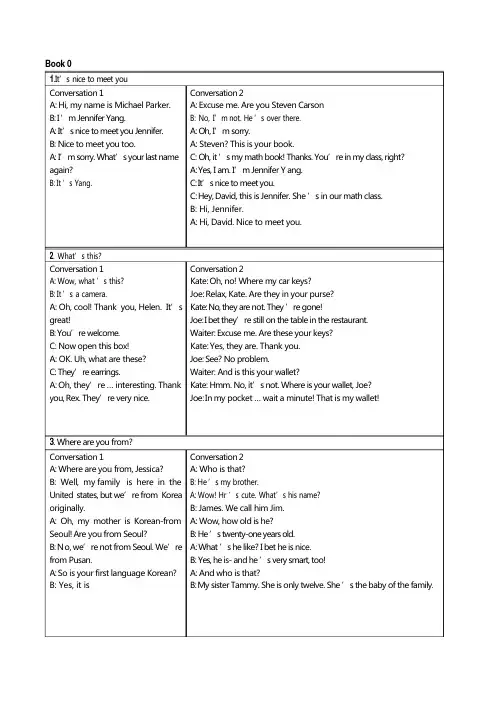
Book01.It’s nice to meet youConversation 1Conversation 2A: Hi, my name is Michael Parker. A: Excuse me. Are you Steven CarsonB: I ’m Jennifer Yang.B:No,I’m not.He’s over there.A: It’s nice to meet you Jennifer.A: Oh, I’m sorry.B: Nice to meet you too. A: Steven? This is your book.A: I’m sorry. What’s your last nam e C: Oh, it ’s my math book! Thanks. You’re in my class, right? again? A:Yes, I am. I’m Jennifer Y ang.B:It’s Yang.C: It’s nice to meet you.C: Hey, David, this is Jennifer. She ’s in our math class.B: Hi, Jennifer.A: Hi, David. Nice to meet you.2.What’s this?Conversation 1Conversation 2A:Wow,what’s this?Kate: Oh, no! Where my car keys?B:It’s a camera.Joe: Relax, Kate. Are they in your purse?A: Oh, cool! Thank you, Helen. It’s Kate: No, they are not. They ’re gone!great! Joe: I bet they’re still on the table in the restaurant.B: You’re welcome. Waiter: Excuse me. Are these your keys?C: Now open this box! Kate: Yes, they are. Thank you.A: OK. Uh, what are these? Joe: See? No problem.C: They’re earring s. Waiter: And is this your wallet?A: Oh, they’re … interesting. Thank Kate: Hmm. No, it’s not. Where is your wallet, Jo e?you, Rex. They’re very nice.Joe: In my pocket … wait a minute! That is my wallet!3. Where are you from?Conversation 1Conversation 2A: Where are you from, Jessica? A: Who is that?B: Well, my family is here in the B:He’s my brother.United states, but we’re from Korea A:Wow!Hr’s cute.What’s his name?originally. B: James. We call him Jim.A: Oh, my mother is Korean-from A: Wow, how old is he?Seoul! Are you from Seoul? B: He ’s twenty-one years old.B: N o, we’re not from Seoul. We’re A: What ’s he like? I bet he is nice.from Pusan. B: Yes, he is- and he ’s very smart, too!A: So is your first language Korean? A: And who is that?B: Yes, it is B:My sister Tammy. She is only twelve. She ’s the baby of the family.4.I’m not wearing boots!A: Great! Our clothes are dry. Where is my A: Oh, no!new blouse? B: What ’s the matter?B: What color is it? A: It’s snowing, and it’s very co ld!A: It’s white. B: Are you wearing your glov es?B: Here is a light blue blouse. Is it yours? A: No, they’re at home.A: No, it ’s not mine … wait. It is mine. It ’s a B: Well, you are wearing your coat.disaster! A: But my coat isn ’t warm. And I’m not wearing boot s!B: Oh, no! All our clothes are light blue! B: OK ! Let ’s take a taxi.A: Here’s the problem. It’s these new blue A: Thanks Juli e.jeans. Whose jeans are they?B: Uh, they’re mine. Sorry.5.What are you doing?Conversation 1 Conversation 2A: Hello? A: Hi, Mom.B: Hi, Debbie. This is John. I’m calling B: What are you doing, Stave?from Australia. A: I’m cooking.A: Australia? B: Why are you cooking now? it ’s two o’clock in the morning! B: I’m at a conference, in Sydney. A: Wel, I’m really hungry.Remember? B: What are you making?A: Oh, right. What time is it there? A: PizzaB: It’s 10:00 P.M. And it ’s four o’clock B: Mmm, pizza. Now I’m getting hungry. Let ’s eat!there in Los Angeles. Right?A: Yes-four o ’clock in the mornin g.B: 4:00 A.M? Oh, I’m really sorry.A: That’s OK, I’m awake … now.6.My sister works down townConversation 1 Conversation 2A: Nice car, Jason! Is it yours? A: Let ’s go to the park on Sunday.B: No, it ’s my sister ’s. she has a new job, B: OK, but let’s go in the afternoon. I sleep late on weekends. and she drives to work. A: What time do you get up on weekends?A: is her job here in the suburbs? B: At ten o’clockB: No, it ’s downtown. A: Oh, that’s early. On Sundays I get up at noon.A: my parents work downtown, but they B: Do you eat breakfast then?don’t drive to work. They use public A: Sure. I have breakfast every day.transportation. B: Then let’s meet at this restaurant at one o ’clock. They se rve B: The bus or the train? breakfast all day.A: The train doesn ’t stop near our house, s othey take the bus. It’s really slo w.B:That’s too bad.7.Does it have a view?Conversation 1A: Guess what! I have a new apartment.B: That’s great! What’s it like?A:It’s really beautiful.B: Is it very big?A: Wel, it has a big living room, a small bedroom, a bathroom, and a kitchen.B: Where is it?A: On Lakeview Drive.B: Oh, nice! Does it have a view?A: Yes, it does. It has a great view of another apartment building!8.What do you do?Conversation 1A: Where does your brother work?B: In a hotel.A: Oh, really? My brother works in a hotel, too. He’s a front desk agent.B: How does he like it?A: Not very much. He doesn’t like the manager. B: That’s too bad. What hotel does he work fo r? A: The Plaza.B:That’s funny.My brother work’s there,too. A: Oh, that’s interesting. What does he do? B:Actually,he’s the manager!9.Broccoli is good for you.Conversation 1A: What do you want for the picnic?B: Hmm. How about some sandwiches?A: OK. We have some chicken in the refrigerator, but we don’t have any bread.B: And we don’t have any cheese.A: Do we have any drinks?B: No, we need some.A: All right. Let ’s get some lemonade.B:And let’s buy some potato salad.A: Sure. Everyone likes potato salad. Conversation 2A: This apartment is great.B: Thanks. I love it, but I really need some furniture.A: What do you need?B: Oh, I need lots of things. There are some chairs in the kitchen, but there isn’t a table.A: And there’s no sofa here in the living roo m.B: And there aren ’t any hairs. There’s only this lamp.A: So let ’s go shopping next weekend!Conversation 2A: Hey, Stephanie. I hear you have a new job.B: Yes. I’m teaching math at Lincoln High School.A: How do you like it?B: It ’s great. The students are terrific. How are things with you?A: Not bad. I’m a firefighter now, you now.B: That’s exciting!A: Yes, but it ’s a very stressful job. And sometimes it ’s dangerous.Conversation 2A: Let ’s have breakfast together on Sunday.B: OK. Come to my house. My family always has a Japanese-style breakfast on Sundays.A: Really? What do you have?B: We usually have fish, rice, and soup.A: Fish for breakfast? That ’s interesting.B: Sometimes we have a salad, too. And we always have green tea.A: Well, I never eat fish for breakfast, but I like to try new things.10.I can’t ice- skate very well.Conversation 1A: So, Justin, what do you do in your free time? B: Well, I love sports.A: Really? What sports do you like?B: Hmm. Hockey, baseball, and soccer are my favorites.A: Wow, you are a realy good athlete! When do you play all these sports?B: Oh, I don’t play these sports. I just watch the m on television!11.What are you going to do?Conversation 1A: Are you going to any thing exciting this weekend?B: Wel, I’m going to celebrate in my birthday. A: Fabulous! When is your birthday, exactly? B:It’s August ninth-Sunday.A: So what are your plans?B: Well, my friend Kayla is going to take me out for dinner.A: Nice! Is she going to order a cake?B: Yeah, and the waiters are probably going to sing “Happy Birthday ” to me. It’s so embarrassing.12.What’s the matter?Conversation 1A: Hey, Kenichi. How are you?B: Oh, I’m not so good, actually.A: Why? What is the matter?B: Well, I have a headache. And a backache.A: Maybe you have the flu.B: No, I think I just feel a little homesick for Japan.A: That ’s too bad … . But maybe I can help. Let ’s have lunch at the new Japanese restaurant.B: That’s a great idea. Thanks, Brian. I feel better already! Conversation 2A: Oh, look. There is a talent contest on Saturday. Let’s enter.B: I can ’t enter a talent contest. What can I do?A: You can sing very well.B: Oh, thanks … well, you can, too.A:Oh, no. I can’t sing at all- but I can play the piano.B: So maybe we can enter the contest.A: Sure. Why not?B: OK. Let’s practice tomorro w!Conversation 2A: So, Tyler, are you going to do anything special for Valentine’s day?B: Yeah, I’m going to take my girlfriend out for dinner. A: Oh, really? Where are you going to go?B: Laguna’s. It’s her favorite restaurant.A: Oh, she ’s going to like that!B: How about you? What are you going to do?A: Wel, I’m not going to go to a restaurant, but I’m going to go to a dance.B: Sounds like fun. Well, have a good Valentine’s day.A: Thanks, you, too.Conversation 2A: Hello, Ms. West. How are you today?B: Not so good.A:So, what’s wrong, exactly?B:I’m exhausted!A: Hmm. Why are you so tired?B:I don’t know.I just can’t sleep at night.A: OK. Let’s take a look at you.(A few latter)A: I’m going to give you some pills. Take one pil every night after dinner.B: OK.A: And don ’t drink coffee, tea or soda.B: Anything else?A: Yes. Don’t work too hard.B: All right. Thanks, Dr. Young.13.You can’t miss itConversation 1A: Excuse me. Can you help me? Is there a public rest room around here?B: A public rest room? Hmm. I’m sorry .I don’t think so.A: Oh, no. My soon needs a bathroom.B: Well, there’s a department storeA: Where on Main Street?B: It ’s on the corner of Main and First Avenue. A: On the corner of Main and First Avenue?B: Yes. It’s across from the park. Y ou can’t miss it.A: Thanks a lot!14.Did you have a good weekend? Conversation 1A: Did you have a good weekend?B: Yes, I did. But I feel a little tired today.A: Really? Why?B: Well, on Saturday, I exercised in the morning. Then my roommate and I cleaned and shopped. And then I visited my parents.A: So what did you do on Sunday?B: I studied for the test all day.A: Oh, no! Do we have a test today? I didn ’t study! I just watched TV all weekend! Conversation 2A: Excuse me, ma’am. Can you help me? How do I get to S t. Patrick’s Cathedral?B: Just walk up First Avenue to 50th Street. St. Patrick ’s is on the right.A: Is it near Rockefeller Center?B: It ’s right across from Rockefeller Center.A: Thank you. And where is the Empire State Building?B: Is it from here?A: It’s right behind you. Just around and look up! Conversation 2A: So, did you go out with Sam?B: Yes, I did. We went out on Saturday night. We saw the new Leonardo Di Caprio movie.A: Did you like it?B: I like it a lot, but Sam didn ’t.A: Oh, well. Did you do anything else?B: Yeah. We went to a dance club.A: Did you have a fun?B: Yes, we did. We had a great time. And we ’re going to out again next weekend.15.Where were you born?Conversation 1 Conversation 2A: Where were you born, Melissa? A: Where did you grow up, Chuck?B: I was born in Korea. B: I grew up in Texas. I was born here, too.A: Oh! So you weren’t born in U.S, A: And when did you come to Los Angeles.B: No. I came here in 1995. B: In 1985. I went to college here.A: Hmm. You were pretty young. A: Oh, what was an actor for five years after college?B: Well, I was seventeen. B: That’s interesting. So why did you become a hairstylist? A: Did you go to college right away? A: Because I needed the money. And I love it. Look what do B: No. My English wasn ’t very good, so I took Englishyou think?classes for two years first. B: Well, uh …A: Your English is really fluent now.B: Thanks. Your English is pretty good, too.A: Yeah, but I was born here!Conversation 2 A: Hello? B: Hi, Michael. It’s Jennifer. I got your message. A: Hi, thanks for calling me back. B: So, what ’s up? A: Uh, well, do you want to have dinner with me tomorrow night? B: Tomorrow night? I’m sorry, but I can’t. I have to stay home and study . A: Oh, that’s too bad. How about Friday nigh t? B: UH … .Sure. I’d love to. What do you want to meet? A: How about around seven o’clock? B: Terrific! 16. Please leave us a message. Conversation 1A: Hi. This is Jennifer, and this is Nicole. We can ’t Come to the phone right now. please leave us a Message. And … ...B: Hello?A: Hi, Nicole? It’s Michael. Is Jennifer here? B: Oh, hi, Michael. She’s here, but she’s in Bad-she ’s sleeping. Can she call you later?A: Yeah, thanks. Please ask her to call me at my Parents’house .B: Sure. Just give me the number.ail: It’s 555-0376. Ok.B: Thanks a lot, Nicole.。
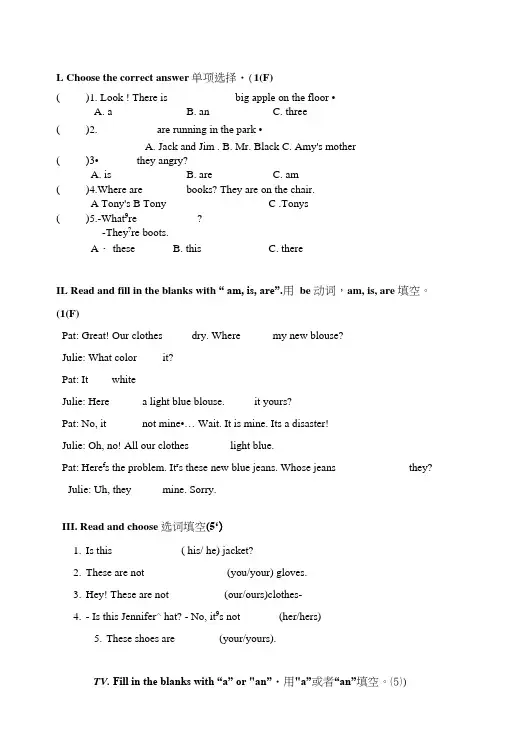
L Choose the correct answer单项选择・(1(F)( )1. Look ! There is ____________ big apple on the floor •A. aB. anC. three( )2. __________ are running in the park •A. Jack and Jim .B. Mr. BlackC. Amy's mother( )3•______ t hey angry?A. isB. areC. am( )4.Where are _______ books? They are on the chair.A Tony'sB TonyC .Tonys( )5.-What9re __________ ?-They?re boots.A・ these B. this C. thereIL Read and fill in the blanks with “ am, is, are”.用be 动词,am, is, are 填空。
(1(F)Pat: Great! Our clothes _____ dry. Where _____ m y new blouse?Julie: What color ___ it?Pat: It ___ whiteJulie: Here _____ a light blue blouse. ____ it yours?Pat: No, it ______ n ot mine•… Wait. It is mine. Its a disaster!Julie: Oh, no! All our clothes _______ light blue.Pat: Here f s the problem. It r s these new blue jeans. Whose jeans ____________ t hey? Julie: Uh, they ____ mine. Sorry.III. Read and choose 选词填空(5‘)1.Is this ____________ ( his/ he) jacket?2.These are not _____________ (you/your) gloves.3.Hey! These are not _________ (our/ours)clothes-4.- Is this Jennifer^ hat? - No, it9s not ______ (her/hers)5.These shoes are _______ (your/yours).TV.Fill in the blanks with “a” or "an”・用"a”或者“an”填空。
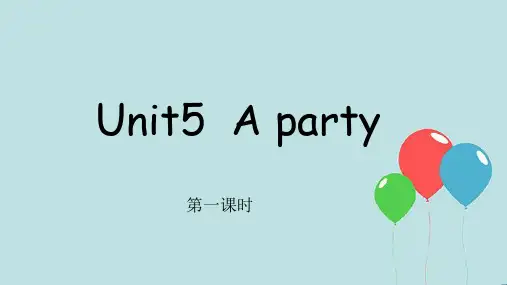
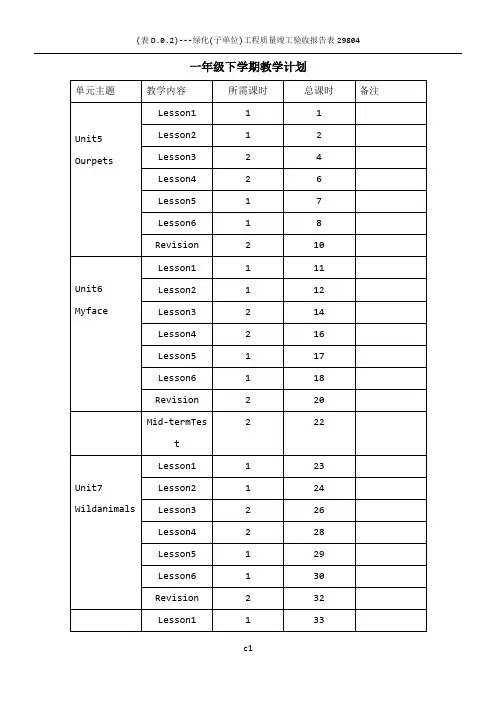
一年级下学期教学计划Unit5Mypets单元目标语言:单词:pet,bird,cat,dog,fish,horse,mouse,big,small,long,short,clean,dirty .句型:What’sthis?It’sahorse/mouse/dog/cat/fish/bird.单元技能目标:听:能够听懂关于宠物的对话,描述宠物的形容词和句子,礼貌用语,辨别/p/的发音;说:能够就宠物的话题进行简单问答,说一首关于宠物描述的歌谣,能唱一首关于宠物的歌曲;读:能读出宠物的名称;写:能正确涂色,能写出数字,能圈出所要选择的项目;第一课时Lesson1教学目标:1、能看图片说出六种动物,并记住他们的分类-pet;2、能听懂关于petshow的对话内容;重点语言:Cat,dog,fish,horse,mouse,bird,petshow教学材料:宠物单词卡片,CD,颜色单词卡片教学步骤:1、Greetingandrollcall.2、展示颜色单词卡片,说:Where’sgrey?等,学生指着相应的卡片说:Here!复习颜色;3、出示宠物单词卡片,例cat,用肢体语言和声音来描述单词,请学生跟做,认读、指认、做动作(发声音)配对;用同样的方式出示其他动物的图片和单词。
4、分组跟读,每组代表一种动物,跟读时大声读出并站起来;男女生分组拍卡片,老师说,学生拍出相应的图片;5、请学生翻看第1部分,回答问题:whatcanyousee?Whocanyousee?播放CD,请学生仔细听,教师释义show,lovely并解释整个对话的意思,听第二遍,指认听到的宠物;6、听第2部分CD,指认并跟读;7、结束本课;作业:第1部分听两遍,理解意思,第二部分听、指认并跟读;请家长听写单词,学生在作业单上画出宠物。
第二课时Lesson2教学目标:1、复习宠物、形容词和颜色;2、会说一首关于描述宠物的歌谣;重点语言:6个宠物,形容词:beautiful,ugly,young,happy,教学材料:宠物单词卡片教学步骤:1、Warmup:1)和全体同学打招呼,再和个别学生打招呼;2)点名(Rollcall).3)Hi,Hellosong.2、复习宠物:(1)将宠物卡片放在黑板上,教师用纸片遮住大部分,露出一角,请学生说出宠物名称,并提问:Isthe____young/old/beautiful/ugly/happy/sad?(2)将宠物卡片摆放在黑板上,请学生闭眼,教师拿走一张,让学生猜出whichoneismissing?The____ismissing.3、请学生翻看第3部分图片,分享各个宠物的特点;教师播放CD,听chant,播放第二遍跟读;第三遍和老师读;第四遍男女生分组读;第五遍教师一组,其余每列一组扮演各种动物,一起来说;4、请学生单个展示;5、听第4部分,Listenandsaythenumber.结束本课作业:会说chant.听第4部分,并说出对应的数字。
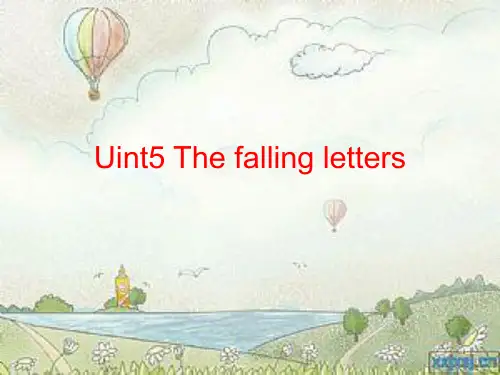
《剑桥国际少儿英语》第一册教案Array Unit 5 Our Pets
单元目标语言:语词cat, dog, fish, horse, mouse, bird, (red) and (blue), long, short, big, small, clean, dirty, Penny Penguin,发音/p/ 结构They’re (ugly/big),复数
单元技能目标: 听能够听懂问候的常用语,教师和课本上的指令语,宠物的名称,形容词,辨别/p/的发音
说能够就宠物的话题进行简单回答,用形容词描述宠物,能说唱歌谣、歌曲
读能认读部分颜色、数字、形容词的单词,全部宠物的单词
写能正确涂色,能写出数字,能圈出所要选择的项目,能抄写部分宠物和形容词的单词
第一课时Lesson 1
课堂教学过程(40 mins)
第二课时Lesson 2
课堂教学过程(40 mins)
第三课时Lesson 3
课堂教学过程(40 mins)
第四课时Lesson 4
课堂教学过程(40 mins)
第五课时Lesson 5
课堂教学过程(40 mins)
第六课时Lesson 6
课堂教学过程(40 mins)。
剑桥国际少儿英语第5级Here is an essay on the topic of "Cambridge Young Learners English Test Level 5" with more than 1000 words, written in English without any additional titles or punctuation marks.The Cambridge Young Learners English Test Level 5 is a comprehensive assessment designed to evaluate the English language proficiency of young learners aged 11-14. This internationally recognized exam is a crucial milestone in the academic and linguistic development of students, as it not only assesses their overall command of the English language but also provides valuable insights into their progress and areas for improvement.One of the primary benefits of the Cambridge Young Learners English Test Level 5 is its ability to objectively measure a student's language skills across a range of domains. The test evaluates the student's proficiency in reading comprehension listening comprehension writing and speaking all of which are essential components of effective communication in English the global language of business education and cultural exchangeThe reading comprehension section of the exam assesses the student's ability to understand a variety of written materials from short narratives to informative passages The questions in this section are designed to test the student's ability to identify key information extract relevant details and draw logical conclusions from the given texts This component not only evaluates the student's vocabulary and grammar knowledge but also their critical thinking skills as they navigate through complex written materialsThe listening comprehension section of the test is equally important as it gauges the student's ability to comprehend spoken English in various contexts The exam presents the student with a range of audio recordings including conversations interviews and announcements which the student must then respond to accurately through multiple choice or short answer questions This section not only tests the student's listening skills but also their ability to process and understand spoken language in real-time a crucial skill for effective communication in academic and professional settingsThe writing section of the Cambridge Young Learners English Test Level 5 assesses the student's ability to express themselves coherently and effectively in written form The student is typically required to compose a short essay or narrative on a given topic demonstrating their command of grammar vocabulary and organizational structure This component is particularly valuable as itallows the student to showcase their ability to communicate their ideas in a clear and structured manner a skill that is highly valued in academic and professional contextsFinally the speaking section of the exam evaluates the student's oral communication skills The student is required to engage in a series of interactive tasks such as role-playing conversations describing images and expressing opinions on various topics This section not only assesses the student's pronunciation and fluency but also their ability to communicate effectively in real-time adapt to different conversational scenarios and think critically about the topics being discussedOne of the key advantages of the Cambridge Young Learners English Test Level 5 is its ability to provide a comprehensive and objective assessment of a student's English language proficiency The exam is designed to be a reliable and valid measure of a student's language skills and the results are recognized by educational institutions and employers around the world This recognition can be particularly valuable for students who are planning to pursue further education or seek employment in an international context as it demonstrates their mastery of the English language a crucial asset in today's globalized worldMoreover the Cambridge Young Learners English Test Level 5 is notsimply a one-time assessment but rather a part of a broader framework of language examinations offered by Cambridge Assessment English The test is aligned with the Common European Framework of Reference for Languages CEFR which is an internationally recognized standard for language proficiency This means that the results of the Level 5 exam can be used to track a student's progress and identify areas for further development as they continue their language learning journeyIn addition to its academic and professional benefits the Cambridge Young Learners English Test Level 5 can also have a positive impact on a student's personal growth and confidence The exam provides a structured and supportive environment for students to showcase their language skills and receive feedback on their performance This can be particularly empowering for young learners who may have previously struggled with English or lacked confidence in their abilitiesBy successfully completing the Cambridge Young Learners English Test Level 5 students can gain a sense of accomplishment and pride in their language learning achievements This can in turn boost their self-esteem and motivation to continue improving their English proficiency further reinforcing the value of the exam as a tool for personal and academic developmentOverall the Cambridge Young Learners English Test Level 5 is a comprehensive and highly regarded assessment that offers numerous benefits to students seeking to enhance their English language skills The exam's focus on evaluating a range of language competencies reading listening writing and speaking provides a well-rounded and accurate representation of a student's overall proficiency Additionally the recognition and prestige associated with the Cambridge Assessment English brand can open up a world of opportunities for young learners as they navigate their academic and professional journeys in an increasingly globalized world。